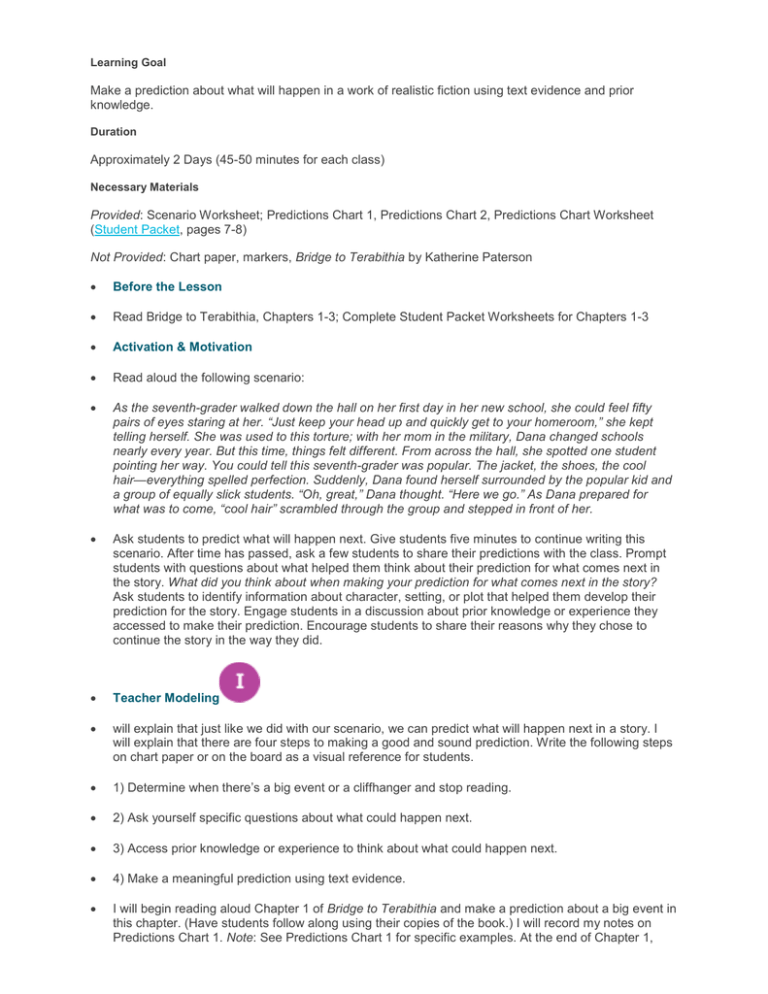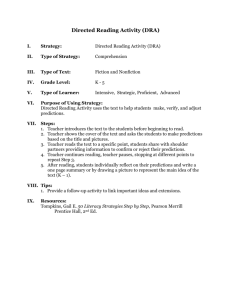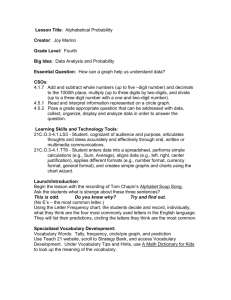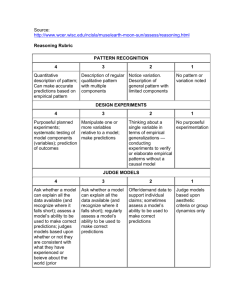BridgeToTerabithiaLessonPlan
advertisement

Learning Goal Make a prediction about what will happen in a work of realistic fiction using text evidence and prior knowledge. Duration Approximately 2 Days (45-50 minutes for each class) Necessary Materials Provided: Scenario Worksheet; Predictions Chart 1, Predictions Chart 2, Predictions Chart Worksheet (Student Packet, pages 7-8) Not Provided: Chart paper, markers, Bridge to Terabithia by Katherine Paterson Before the Lesson Read Bridge to Terabithia, Chapters 1-3; Complete Student Packet Worksheets for Chapters 1-3 Activation & Motivation Read aloud the following scenario: As the seventh-grader walked down the hall on her first day in her new school, she could feel fifty pairs of eyes staring at her. “Just keep your head up and quickly get to your homeroom,” she kept telling herself. She was used to this torture; with her mom in the military, Dana changed schools nearly every year. But this time, things felt different. From across the hall, she spotted one student pointing her way. You could tell this seventh-grader was popular. The jacket, the shoes, the cool hair—everything spelled perfection. Suddenly, Dana found herself surrounded by the popular kid and a group of equally slick students. “Oh, great,” Dana thought. “Here we go.” As Dana prepared for what was to come, “cool hair” scrambled through the group and stepped in front of her. Ask students to predict what will happen next. Give students five minutes to continue writing this scenario. After time has passed, ask a few students to share their predictions with the class. Prompt students with questions about what helped them think about their prediction for what comes next in the story. What did you think about when making your prediction for what comes next in the story? Ask students to identify information about character, setting, or plot that helped them develop their prediction for the story. Engage students in a discussion about prior knowledge or experience they accessed to make their prediction. Encourage students to share their reasons why they chose to continue the story in the way they did. Teacher Modeling will explain that just like we did with our scenario, we can predict what will happen next in a story. I will explain that there are four steps to making a good and sound prediction. Write the following steps on chart paper or on the board as a visual reference for students. 1) Determine when there’s a big event or a cliffhanger and stop reading. 2) Ask yourself specific questions about what could happen next. 3) Access prior knowledge or experience to think about what could happen next. 4) Make a meaningful prediction using text evidence. I will begin reading aloud Chapter 1 of Bridge to Terabithia and make a prediction about a big event in this chapter. (Have students follow along using their copies of the book.) I will record my notes on Predictions Chart 1. Note: See Predictions Chart 1 for specific examples. At the end of Chapter 1, someone is moving in next door. This is both a major event and a cliffhanger at the end of the chapter. I’ll record this information under the column labeled “Identify a big event or cliffhanger” on my Predictions Chart. Now I need to ask specific questions to give me more information about what could happen next. The author tells us that someone is moving in next door, but not much more information is given. So, I can ask: Who is moving in? Will they be friendly or unfriendly? How will this impact Jess’s life? I’ll record these questions under the column labeled “Ask specific questions about what could happen next” on Predictions Chart 1. Next, I will use prior knowledge to think about the answers to these questions. Since I have already done some Pre-Reading work (for example, I’ve read the back cover of the book), I know that Leslie, the new girl at school, beats Jess in a race and the two later form a friendship. I’ll record this information under the column labeled “Think about prior knowledge or experience” on Predictions Chart 1. Finally, I can make a meaningful prediction using text evidence from the information on the back cover. I predict that Leslie has moved in next door to Jess. The two will form a friendship that will have a positive impact on Jess’s life. I will write this prediction on Predictions Chart 1, under the column labeled, “Make a meaningful prediction using text evidence.” I will continue to read aloud Chapter 2 and model making predictions as I find a big event in the story, or a cliffhanger. (Have students follow along using their copies of the book.) Note: Fill in details and predictions on the Predictions Chart as you continue to read through Chapter 2. I will explain that predictions can change as you continue to read a story and gather additional details and information. I will revisit Predictions Chart 1 to adjust my predictions and to make additional predictions as I read the story. Think Check Ask: "How do I make a prediction about what’s coming up next in a story?" Students should respond that there are four steps to making a sound prediction. First, identify a big event or cliffhanger. Then, identify missing information and ask questions about the event to think about what could happen next. Next, access prior knowledge and experience to think about what could happen next. Finally, make a prediction and support it with details from the text. Guided Practice will read aloud Chapter 3 of Bridge to Terabithia. We will look big events or cliffhangers that we can make a prediction about. We will ask specific questions about what could happen next, and we will access prior knowledge or experience to answer our questions. We will use this information to make a meaningful prediction using text evidence. We will fill out Predictions Chart 2 as we make predictions for Chapter 3. Note: See Predictions Chart 2 for a sample chart. Some additional examples for the chart include: Jess will continue to practice running in order to beat Leslie; Leslie might apologize to Jess for beating him, etc. Independent Practice will read Chapter 4 and look for big events or cliffhangers. As you come across a big event or cliffhanger that you think can help you make a prediction, you will think of specific questions about what could happen next. Then, you will think about your prior knowledge and experience to answer those questions. Finally, you will make a meaningful prediction using text evidence. You will complete the Predictions Chart Worksheet in your Student Packet for Chapter 4. You may make as many predictions as you wish. (See pages 7-8 in the Student Packet.) Reflective Practice will share one prediction with the class. As you hear a prediction you didn’t make, you will record this prediction and the detail/hint that corresponds with this prediction on the Predictions Chart Worksheet in your Student Packet. We will return to our predictions as we read to change them or add to them, and to make additional predictions as we come across hints in the chapters that follow.







